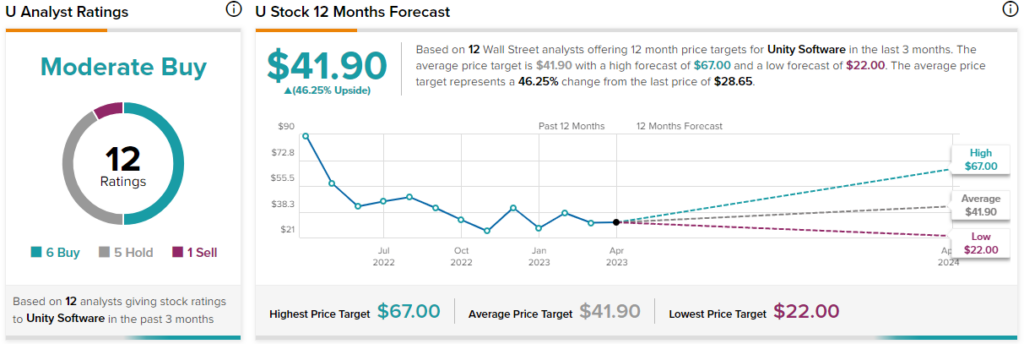Gaming software giant Unity Software (NYSE:U) perhaps looks like a “dead” stock. It’s now trading at $28.65, about 86% lower than its all-time high of $210 in November 2021. While investors still have reasons to not lose all hope in this gaming industry leader, I will stay on the sidelines until better signs of recovery emerge.
Elevate Your Investing Strategy:
- Take advantage of TipRanks Premium at 50% off! Unlock powerful investing tools, advanced data, and expert analyst insights to help you invest with confidence.
2022 was a dismal year for Unity. With the overall macro weakness, the gaming and advertising markets have weakened too. Furthermore, a reported problem in its software within the Operate segment has led to pressure on its stock. While the issues, according to management, have been fixed, investors’ confidence hasn’t returned to the stock yet. Nonetheless, let’s take a look at Unity Software closely.

Slowing Mobile Gaming and Ad Business
Unity offers software to 3D video game developers, helping them create games with the best-quality graphics. Not just that, it offers a comprehensive platform for managing video games from publishing to monetization via advertising. This means that once created, a game can be a continuous source of revenue for Unity for its lifespan, thanks to the services offered by the company.
On the downside, however, Unity’s gaming segment revenues have suffered and have been on a continuous decline over the past few quarters.
After reporting strong revenue numbers in the prior years (2020: 44%, 2021: 43%), revenue growth fell to 22% in 2022. That turned away investors, especially given the fact that the company is not profitable yet.
The reason investors were holding to the stock was based on the expectations that impressive revenue growth would convert to profitability soon. The company targets an annual run-rate in EBITDA of $1 billion by 2024 end. However, looking at the current scenario, the firm’s profitability goals may be pushed out further.
Unity reported upbeat Q4 results in February but issued 2023 guidance with a “wider revenue range given the market uncertainty,” which upset investors, pushing shares lower. The stock has been volatile in the past few months and is expected to remain so in the coming months.
Nonetheless, as per management, the Create Solutions segment (44% of revenues in 2022) and the Grow Solutions segment are expected to continue to maintain their strong revenue growth profile. This is despite an expected contraction of approximately 10% in the in-game ads market (which is relevant to the Grow Solutions segment).
Diversification Into Newer Verticals
Mobile gaming historically presented the lion’s share of Unity’s total revenues. However, that may change soon as the company looks to diversify to newer industries.
For instance, Unity is actively looking to take advantage of the highly-trending generative artificial intelligence (AI) market. After the launch of OpenAI’s ChatGPT in November 2022, many software companies are aiming to get into this market.
Unity already uses AI for its operations, and entering the niche space complements Unity’s existing capabilities. Recently, Unity’s management revealed its plans to create a marketplace for generative AI software wherein creators can make content immediately with AI products.
However, the timeline or the probable launch date has not been disclosed yet. On March 22, Unity launched an early-access program for developers for its future AI offerings. Further details may come out in the upcoming Q1 earnings scheduled to release on May 10.
Meanwhile, Unity is also increasing its focus on the digital twin market. The market comprises software/platform services that create virtual digital replicas of a component, asset, or enterprise. As per GlobalData, the market is expected to grow at a CAGR of 36% until 2030, thanks to higher adoption of technologies like artificial intelligence (AI), internet of things (IoT) platforms, and more across various industries.
While Unity has not separately reported revenues for this niche segment, its contribution to the Create Solutions segment grew significantly in 2022. According to CEO John Riccitiello, the segment from this space grew more than 100% during 2022, which is outstanding.
Unity Software is also expanding into the visual effects industry with its acquisition of Weta Digital in November 2021 for over $1.6 billion. Though the company has not given out any details on the growth prospects, management may lay out its execution plans during the second half of 2023.
Is Unity Stock a Buy, According to Analysts?
As per TipRanks, analysts are cautiously optimistic about Unity Software stock and have a Moderate Buy consensus rating, which is based on six Buys, five Holds, and one Sell. Unity Software’s average price forecast of $41.90 implies 46.3% upside potential.

In terms of valuation, Unity has mostly traded at a premium to its peers due to its industry-leading position and diversified revenue stream. At present, the company is trading at an EV/sales ratio of 8.9x, higher than the peer group average of 2.8x. Yet, it is trading at much lower levels compared to the average EV/sales valuation of 30x seen in the past.
Conclusion: I’m Waiting on the Sidelines
Unity remains in an investment phase with a long runway for growth backed by a diversified business model with newer verticals being added. However, due to present macro uncertainties and other challenges facing the stock, such as software issues, geopolitical tensions in China, costly acquisitions resulting in increased debt and share dilution, and the effects of significant share-based compensation, the company’s profitability objectives may take longer to achieve.
Growth from newer business verticals and synergies from its relatively expensive acquisitions made in the recent past (especially ironSource for $4.4 billion) may reveal themselves after a few quarters. While I believe in the long-term growth story, I will wait for more visible signs of a recovery before buying the stock. Until then, I will remain on the sidelines.
















